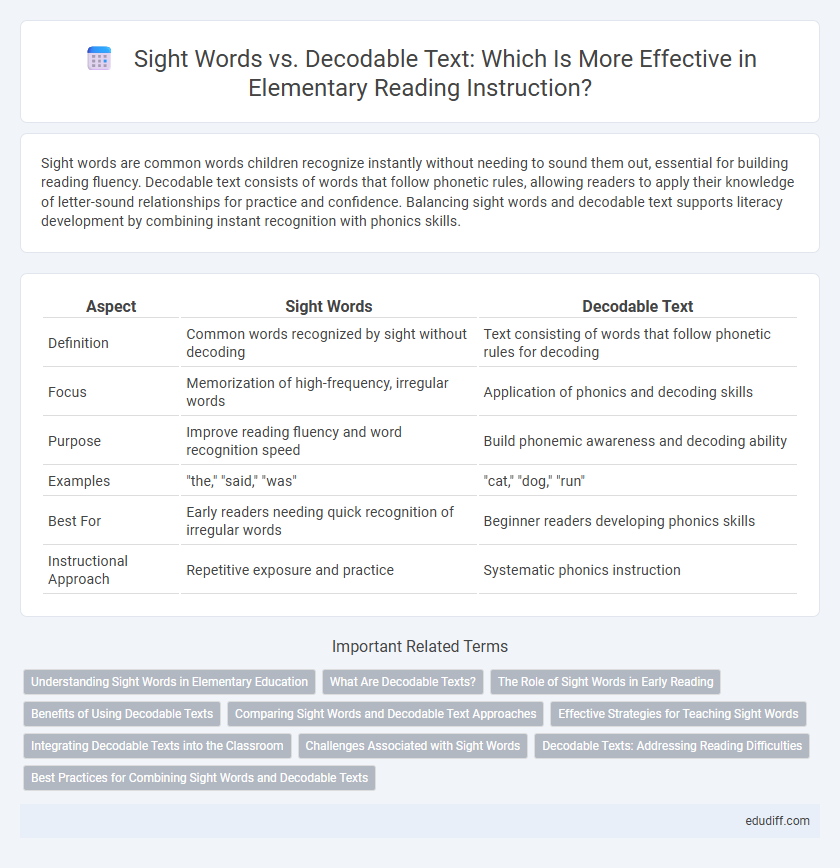Sight words are common words children recognize instantly without needing to sound them out, essential for building reading fluency. Decodable text consists of words that follow phonetic rules, allowing readers to apply their knowledge of letter-sound relationships for practice and confidence. Balancing sight words and decodable text supports literacy development by combining instant recognition with phonics skills.
Table of Comparison
| Aspect | Sight Words | Decodable Text |
|---|---|---|
| Definition | Common words recognized by sight without decoding | Text consisting of words that follow phonetic rules for decoding |
| Focus | Memorization of high-frequency, irregular words | Application of phonics and decoding skills |
| Purpose | Improve reading fluency and word recognition speed | Build phonemic awareness and decoding ability |
| Examples | "the," "said," "was" | "cat," "dog," "run" |
| Best For | Early readers needing quick recognition of irregular words | Beginner readers developing phonics skills |
| Instructional Approach | Repetitive exposure and practice | Systematic phonics instruction |
Understanding Sight Words in Elementary Education
Sight words are high-frequency words that young readers recognize instantly without decoding, enabling smoother reading fluency in elementary education. These words often include irregular spellings and common words like "the," "said," and "come," which are essential for building reading confidence. Mastery of sight words supports comprehension by reducing cognitive load, allowing students to focus on decoding unfamiliar words and understanding text.
What Are Decodable Texts?
Decodable texts are reading materials designed with phonics rules to help elementary students practice sounding out words. These texts use controlled vocabulary that aligns with the letters and sounds children have learned, supporting early reading development. By focusing on letter-sound correspondence, decodable texts build foundational skills essential for fluent reading.
The Role of Sight Words in Early Reading
Sight words are high-frequency words that often cannot be sounded out easily, making recognition of these words crucial for early readers to build fluency and comprehension. Decodable text supports phonics-based learning by allowing children to apply letter-sound rules in context, while sight words help bridge gaps for irregular words. Mastery of sight words improves reading speed and confidence, enabling young learners to focus on meaning rather than decoding every word.
Benefits of Using Decodable Texts
Decodable texts support early readers by aligning with phonics instruction, helping children apply letter-sound relationships to decode words independently. This targeted practice builds confidence and improves reading fluency, essential for developing strong literacy skills in elementary students. Research shows that decodable text use leads to better word recognition and comprehension compared to reliance on sight words alone.
Comparing Sight Words and Decodable Text Approaches
Sight words are high-frequency words recognized by memorization, aiding early reading fluency, whereas decodable text emphasizes phonics by using words that follow specific sound-letter rules to build decoding skills. Decodable text supports systematic phonics instruction, helping students apply sound patterns for accurate reading, while sight word practice focuses on instant recognition of irregular or common words that don't follow phonetic rules. Combining both approaches enhances reading development by balancing phonics-based decoding strategies with the rapid identification of essential sight words.
Effective Strategies for Teaching Sight Words
Effective strategies for teaching sight words in elementary education include using visual aids, repetitive practice, and incorporating sight words into meaningful sentences. Flashcards and engaging games help reinforce recognition, while multisensory activities such as tracing and writing support retention. Frequent exposure to sight words in various contexts ensures students build strong automatic recognition skills essential for fluent reading.
Integrating Decodable Texts into the Classroom
Integrating decodable texts into the elementary classroom strengthens foundational phonics skills by providing students with controlled vocabulary that emphasizes sound-symbol relationships. These texts support early readers in applying decoding strategies, which enhances fluency and confidence compared to sight words alone. Using decodable books alongside sight word practice creates a balanced literacy approach that addresses both word recognition and phonemic awareness.
Challenges Associated with Sight Words
Sight words often present challenges for elementary learners because they do not follow regular phonetic rules, making them difficult to sound out. This irregularity can hinder reading fluency and slow down the development of decoding skills in young readers. Teachers must balance repetitive practice with engaging activities to help students recognize these high-frequency words automatically.
Decodable Texts: Addressing Reading Difficulties
Decodable texts provide students with controlled vocabulary patterns that align with phonics instruction, facilitating word recognition and decoding skills critical for early readers. These texts help address reading difficulties by enabling learners to practice applying phonetic rules, which improves fluency and confidence in decoding unfamiliar words independently. Research shows that consistent exposure to decodable text supports the development of foundational reading skills, especially for children struggling with reading acquisition.
Best Practices for Combining Sight Words and Decodable Texts
Combining sight words and decodable texts in elementary reading instruction supports balanced literacy development by enhancing both word recognition and phonics skills. Effective practices include introducing high-frequency sight words alongside decodable texts that align with phonetic patterns, allowing students to build fluency and confidence. Regular assessment and targeted reinforcement ensure students master sight words while decoding unfamiliar words in context.
Sight Words vs Decodable Text Infographic

 edudiff.com
edudiff.com